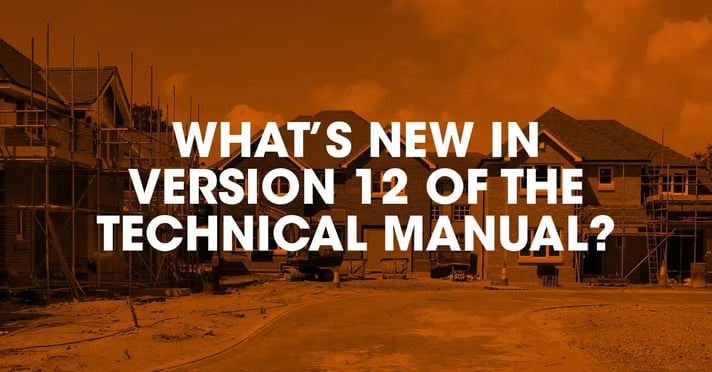What’s new in Version 12?
We’ve summarised a few of the most crucial updates for the next edition of the LABC Warranty Technical Manual, and you can also find a link to the full change log here.
Ground Conditions
Having been moved to the start of the Technical Manual back Version 11, there are two new changes to Section 1, Ground Conditions.
Guidance itself has been updated to make it easier for readers to understand. This includes a new and easier-to-use flow chart, and new guidance for a basic ground investigation which is required where the phase one site investigation doesn’t flag any hazards.
In addition, the Functional Requirements now ask for site investigations to be dated within five years of construction starting on site.
Basements
Functional Requirements on Section 2, Basements, have been updated, requiring an engineer to design integral waterproofing structures such as foundations, walls and floors. They must be designed to support vertical loading, resist horizontal loading and resist surcharges including the influence of trees and nearby topography.
Foundations
Two subsections of Section 3, Foundations, have been combined. These sections are Mass Fill (sub-section 3.1) and Strip (subsection 3.2). They are now combined into a section called Mass Fill and Strip.
Other changes include:
- Guidance on vibratory ground improvement has been updated to reflect best practice.
- Subsection Trees and Clay has been updated to incorporate:
- Simplified ‘Changes in Level’ guidance.
- New guidance on heave precaution in varying situations.
- Updated advice for rafts, and strip and fill foundation, when used on shrinkable/expandable soil.
- New guidance around flexible and rigid retaining walls.
- New advice on the use of helical (screw) piles.
Ground Floors
New advice in Section 4, Ground Floors, outlines guidance on stepped party walls.
External Walls
Section 6, External Walls, has been updated to include:
- Functional requirements have been updated to clarify that means of escape, passive and active systems are not covered by Warranty.
- Section 6 specifies that external walls are to be built to Building Regulations.
- The table for ‘suitable cavity wall construction depending on exposure, for use with full fill cavity insulation’ has been updated.
Updated requirements are included for:
- Spandrel panels.
- Breather members in timber frame and light gauge steel sections.
- Natural stone masonry.
- Testing curtain walling systems.
A new ‘provision of information’ is added to cladding types in sub-section 6.5.
Clearer guidance on lateral restraint is also included.
Externals Windows and Doors
Section 8, External Windows and Doors, has been updated to offer new requirements for water tightness for glazing systems in developments over six storeys.
In addition, the section of stacked windows has been renamed to ‘Vertically Stacked Coupled Window Assemblies’ to better reflect the type of window being described in the guidance. This section also includes additional guidance on the aforementioned windows.
Stairs
Section 9, Stairs, includes new guidance on glazed guarding.
Roofs
Section 11, Roofs, now states in the functional requirements that, “Means of escape, passive and active systems are not covered by the Warranty”.
Other changes include:
- Sub-sections 11.1 and 11.2, pre-formed truss and traditional cut roofs respectively, have been combined into a new section, Pitched Roof Structures.
- New guidance for interlocking tiles, plain tiles and slates have also been condensed into sub-section Pitched Roof Coverings (Tiles and Slates).
- A new section, Panelised Roof Cassettes, has been introduced.
- Additional guidance is provided where LR underlays are used on a fully-supported material.
- A new table is included to provide guidance on gauge, headlap and permissible pitch for different pitched roof covering types.
- Guidance has been added for additional testing of flat roofs after a test failure.
- Guidance on vegetation-free zones for green roofs has been updated.
The ‘provision of information’ for pre-formed trusses and traditional-cut roofs now includes:
- Third-party product approval certificate for the roof underlay.
- Details of the ventilation strategy for the pitched roof in line with the guidance provided in this section and/or BS 55250.
Garages
Section 19, Garages, has been updated to add guidance for services within a garage.
New guidance in also available for garage floors – we now recommend garage flows should laid to a fall and have a step where they’re integral to the house.
Appendix C
Appendix C provides new guidance around:
- Cavity trays and damp-proof courses.
- Steelwork protection in varying environments.
- Proprietary products and systems in place of a traditional construction method.
- What we expect to see in third part product conformity certificates.
- Service life tables.
Download the full change log complete with all details of every change here.
Or, if you prefer, you can access Version 12 of the Technical Manual in full here.
What comes next?
If you’re a current LABC Warranty customer, and accepted your quote before 1 April 2024, then your site(s) will be held to the standards laid out in Version 11. You can access copies of Version 11 here.
However, if you’re in the process of starting a site with LABC Warranty, and it’s likely that you accept a quote and instruct LABC Warranty on or after 1 April 2024, then your site will be assessed against Version 12 by your assigned Risk Management Surveyor.


Have your say